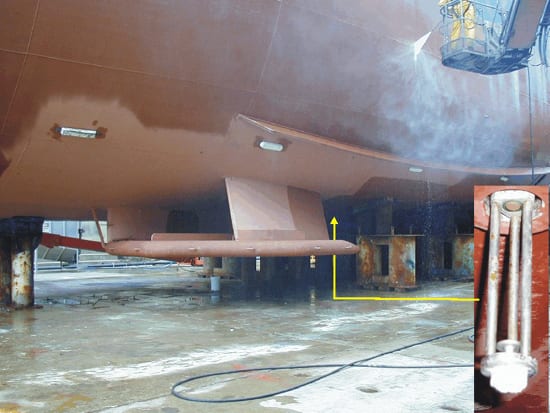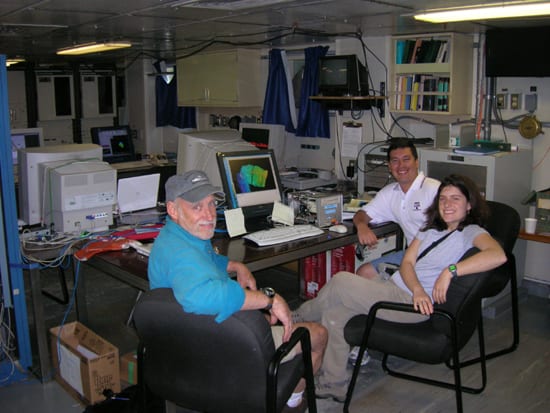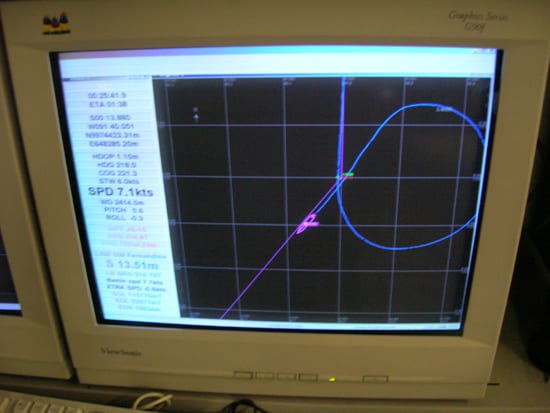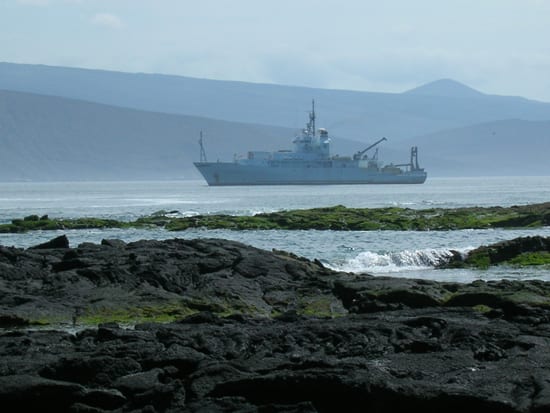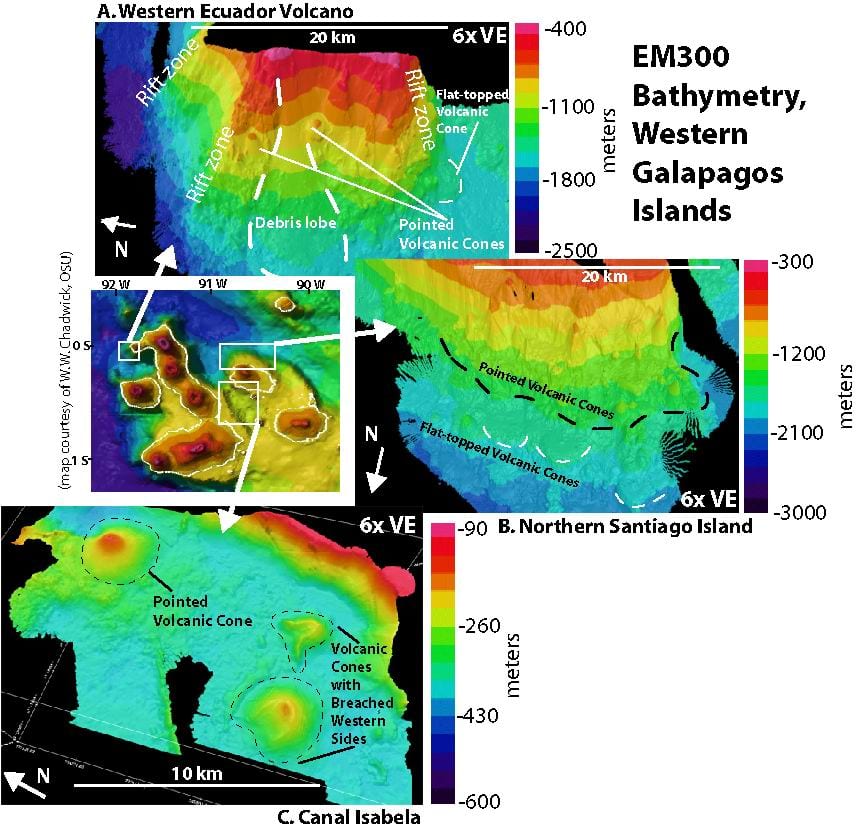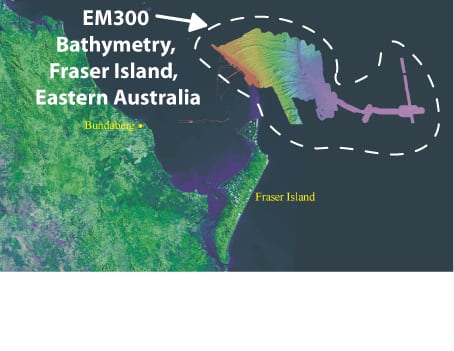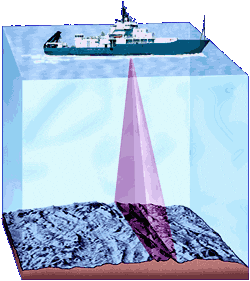Seafloor Mapping Systems
Kongsberg-Simrad EM300 Multibeam Echo Sounder
What is it and why do we use it?
Scientists use the EM300 system to obtain detailed maps of the seafloor. EM300 can be used in water as shallow as 10 meters and as deep as 5000 meters. The EM300 system is very helpful to scientists mapping volcanic seamounts and mid-ocean ridges, as well as submarine volcanoes near subduction zones and hot spot ocean island chains. The EM300 system is also applicable to marine biological habitat analysis. The EM300 system is also useful because it collects information about the relative hardness of the seafloor (sediment vs. lava) by measuring the amplitude of the echoing sound waves.
How does the instrument work?
The EM300 system sends out pings of 30 kHz acoustic energy, pulsing the seafloor with a series of soundings perpendicular to the track of the vessel. The pulses are sent down toward the ocean floor by a transducer that is mounted to the hull of the ship. The beams produce a fanned arc composed of up to 135 individual beams, each with a width as narrow as one vertical degree by one horizontal degree. The width of the swath of sonar echo beams produced by the EM300 system depends on the water depth, with a maximum width of 5000 meters.
Reflected echoes are received by another array that is mounted parallel to the vessel track, which records the time required for the acoustic signal to travel to and from the seafloor. This number can then be converted into water depth to create a bathymetric (water depth) map. Measurements of water column sound velocity profiles are taken daily with a CTD instrument to ensure that the path of each acoustic wave through the water column is accurately measured, both in two-way travel time and where it actually hits the seabed.
Location is determined by very precise global positioning system measurements. Corrections are automatically made for the attitude of the ship, including pitching, rolling, yawing and heaving --- the ship’s heaving, that is! This is very important in rough seas to ensure an even, continuous map. Scientists orient their planned cruise track lines like they are mowing the lawn, so that the mapped areas overlap in order to minimize “holidays,” or data gaps in the maps.
What platforms are needed for its use?
Several international scientific vessels have EM300 systems mounted to their hulls, including the R/V Thomas G. Thompson (operated by the University of Washington, Seattle, WA) and R/V Southern Surveyor (operated by Commonwealth Scientific and Industrial Research Organization; Hobart, Tasmania, Australia). Several computer software programs are utilized for data collection, cleaning and visualization.
What are the advantages of using this instrument?
The EM300 system is a great tool for mapping large areas quickly: the EM300 system operates best when the ship is traveling between 7 and 10 knots (nautical miles per hour). Other multibeam systems, like the DSL-120 towed multibeam system, can produce even higher resolution maps by utilizing higher frequency acoustic energy and are towed less than 100 meters above the seafloor. However, these towed systems require higher maintenance than the EM300 systems, which only requires the click of a mouse to start and stop.
What are the disadvantages of using this instrument?
The outer beams of the EM300 swath can be of low quality, due to speed and signal reception errors because of the great travel distance, large propagation angle and low angle of reflection. These outer portions can be removed using software programs. Ship turns also produce unevenly spaced swaths and data logging is normally paused during turns. It is possible to eliminate data gaps with graceful ship maneuvers such as the “Farmer’s Turn,” however marine mappers lay out survey tracks in straight lines to ensure the high quality data collection.
What's the data look like?
The EM300 system has been used to map the seafloor of numerous regions around the world, from the continental shelf of Vancouver Island, to the rift zones of Hawaii, to the Galapagos Islands. Other multibeam systems have also been used to locate and image sunken ships like the Titanic and map the bottom of Crater Lake, Oregon. Assuming good external sensors and sound speed profile, vertical error with the EM300 system is less than 1%, and horizontal accuracy is determined by the accuracy of the Geographic Positioning System on the ship.
Submarine Galapagos images below were obtained in January 2006 on the R/V <em>Thompson</em> and were processed and gridded at 25 meter resolution with CARIS HIPS and SIPS ® and iView Fledermaus ® software. The total area mapped was approximately 5,000 square kilometers, about the size of the state of Delaware. Marine geologists from the University of Washington (Seattle, Washington), Woods Hole Oceanographic Institution, University of South Carolina and Instituto Oceanografico de la Armada (Guayaquil, Ecuador) are collaborating in compiling EM300 data with other data sets to better understand the volcanic processes that build up the Galapagos platform, including rift zones (sites of focused volcanic eruptions and lava flows), volcanic cones and deep submarine lava flows.
Shown in Figure 1 are bathymetric maps of three regions of the submarine Galapagos. Figure 1A shows the submarine region west of Ecuador Volcano, off the northwestern tip of Isabela Island, Galapagos Islands. Three linear volcanic rift zones of focused eruptive activity are visible propagating to the north, west and southwest. A lobe of debris from a major landslide off the west slide of the volcano about 100,000 years ago was found in between the western and southwestern rift zones. Two different types of volcanic cones are seen: “pointed” volcanic cones and “flat-topped” volcanic cones.
These two different volcanic cone types are also found on the northern submarine flank of Santiago Island (Figure 1B). Pointed volcanic cones are concentrated in areas shallower than about 1500 meters, and flat-topped volcanic cones are found at greater depths. Another region of interest is the shallow (600 meter water depth) area in between Santiago and Isabela Islands, named Canal Isabela, where both complete and “breached” volcanic cones are found, the latter with their western sides missing. Scientists are now exploring the question of the geologic process that removed the western slopes: was it submarine landsliding activity or explosive volcanism, or something else entirely?
Shown in Figure 2 is EM300 bathymetric data for another region, the continental shelf of eastern Australia, just northeast of Fraser Island, Queensland, surveyed in January 2005 on the R/V Southern Surveyor (data courtesy of Earth and Ocean Science Research Group, University of Newcastle, Australia) and processed by Kristian Llewellyn using University of New Brunswick Ocean Mapping Group software. The image depicts the bathymetry of the area from 40 meters down to 4350 meters. Use of the multibeam system was used to produce a detailed topographic map of the area in order to better understand the sediment transport system in the area.
Sources
Jennifer Glass
Woods Hole Oceanographic Institution; University of Washington (Seattle, WA)
Summer Student Fellow 2006, Geology & Geophysics (WHOI)
Kristian Llewellyn
University of New Brunswick (Canada)
Ocean Mapping Group
See Also
U.S. Geological Survey Open-file Report 00-124
Acoustic Mapping of the Regional Seafloor Geology in and Around Hawaiian Ocean Dredged-Material Disposal Sites by Michael E. Torresan and James V. Gardner U.S. Geological Survey Open-file Report 00-124 2000
Kongsberg, Inc., Information Page.
Kristian Llewellyn, Ocean Mapping Group, Univ. of New Brunswick, Canada

